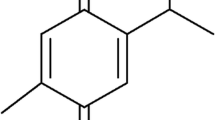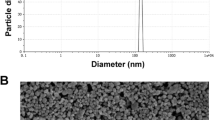Abstract
In the present study, a self-nano-emulsifying drug delivery system (SNEDDS) was developed to evaluate the efficiency of thymoquinone (TQ) in hepatic ischemia/reperfusion. SNEDDS was pharmaceutically characterized to evaluate droplet size, morphology, zeta potential, thermodynamic stability, and dissolution/diffusion capacity. Animals were orally pre-treated during 10 days with TQ-loaded SNEDDS. Biochemical analyses, hematoxylin–eosin staining, indirect immunofluorescence, and reverse transcription polymerase chain reaction (RT-PCR) were carried out to assess cell injury, oxidative stress, inflammation, and apoptosis. The TQ formulation showed good in vitro characteristics, including stable nanoparticle structure and size with high drug release rate. In vivo determinations revealed that TQ-loaded SNEDDS pre-treatment of rats maintained cellular integrity by decreasing transaminase (ALT and AST) release and preserving the histological characteristics of their liver. The antioxidant ability of the formulation was proven by increased SOD activity, reduced MDA concentration, and iNOS protein expression. In addition, this formulation exerted an anti-inflammatory effect evidenced by reduced plasma CRP concentration, MPO activity, and gene expressions of TLR-4, TNF-α, NF-κB, and IL-6. Finally, the TQ-loaded SNEDDS formulation promoted cell survival by enhancing the Bcl-2/Bax ratio. In conclusion, our results indicate that TQ encapsulated in SNEDDS significantly protects rat liver from I/R injury.
Graphical Abstract









Similar content being viewed by others
Availability of data and materials
The authors affirm that the datasets generated during and analyzed during the current study are available from the corresponding author, Dr. Badr Bahloul, on reasonable request.
References
Choi EK, Lim DG. Hepatic ischemia-reperfusion injury with respect to oxidative stress and inflammatory response: a narrative review. J Yeungnam Med Sci. 2022. https://doi.org/10.12701/jyms.2022.00017.
Mendes-Braz M, Elias-Miró M, Jiménez-Castro MB, et al. The current state of knowledge of hepatic ischemia-reperfusion injury based on its study in experimental models. J Biomed Biotechnol. 2012. https://doi.org/10.1155/2012/298657.
Quesnelle KM, Bystrom PV, Toledo-Pereyra LH. Molecular responses to ischemia and reperfusion in the liver. Arch Toxicol. 2015. https://doi.org/10.1007/s00204-014-1437-x.
Teixeira da Silva R, Machado IF, Teodoro JS, et al. PEG35 as a preconditioning agent against hypoxia/reoxygenation injury. Int J Mol Sci. 2022. https://doi.org/10.3390/ijms23031156.
Page RL, O’Bryant CL, Cheng D, et al. Drugs that may cause or exacerbate heart failure: a scientific statement from the American Heart Association. Circulation. 2016. https://doi.org/10.1161/CIR.0000000000000426.
Gaire BP. Herbal medicine in ischemic stroke: challenges and prospective. Chin J Integr Med. 2018. https://doi.org/10.1007/s11655-018-2828-2.
Ali M, Khan T, Fatima K, et al. Selected hepatoprotective herbal medicines: evidence from ethnomedicinal applications, animal models, and possible mechanism of actions. Phytother Res. 2018. https://doi.org/10.1002/ptr.5957.
Sedighi M, Sewell RDE, Nazari A, et al. A review on the most important medicinal plants effective in cardiac ischemia-reperfusion injury. Curr Pharm Des. 2019. https://doi.org/10.2174/1381612825666190329144016.
Ahmad A, Husain A, Mujeeb M, et al. A review on therapeutic potential of Nigella sativa: a miracle herb. Asian Pac J Trop Biomed. 2013. https://doi.org/10.1016/S2221-1691(13)60075-1.
Gholamnezhad Z, Havakhah S, Boskabady MH. Preclinical and clinical effects of Nigella sativa and its constituent, thymoquinone: a review. J Ethnopharmacol. 2016. https://doi.org/10.1016/j.jep.2016.06.061.
Dalli M, Bekkouch O, Azizi S-E, et al. Nigella sativa L. Phytochemistry and pharmacological activities: a review (2019–2021). Biomolecules. 2021. https://doi.org/10.3390/biom12010020.
Rathore C, Rathbone MJ, Chellappan DK, et al. Nanocarriers: more than tour de force for thymoquinone. Expert Opin Drug Deliv. 2020. https://doi.org/10.1080/17425247.2020.1730808.
Darakhshan S, Bidmeshki Pour A, Hosseinzadeh Colagar A, et al. Thymoquinone and its therapeutic potentials. Pharmacol Res. 2015. https://doi.org/10.1016/j.phrs.2015.03.011.
Houghton PJ, Zarka R, de las Heras B, et al. Fixed oil of Nigella sativa and derived thymoquinone inhibit eicosanoid generation in leukocytes and membrane lipid peroxidation. Planta Med. 1995. https://doi.org/10.1055/s-2006-957994.
Bouhlel A, Ben Mosbah I, Hadj Abdallah N, et al. Thymoquinone prevents endoplasmic reticulum stress and mitochondria-induced apoptosis in a rat model of partial hepatic warm ischemia reperfusion. Biomed Pharmacother. 2017. https://doi.org/10.1016/j.biopha.2017.08.018.
Bouhlel A, Bejaoui M, Ben Mosbah I, et al. Thymoquinone protects rat liver after partial hepatectomy under ischaemia/reperfusion through oxidative stress and endoplasmic reticulum stress prevention. Clin Exp Pharmacol Physiol. 2018. https://doi.org/10.1111/1440-1681.12961.
Kooti W, Hasanzadeh-Noohi Z, Sharafi-Ahvazi N, et al. Phytochemistry, pharmacology, and therapeutic uses of black seed (Nigella sativa). Chin J Nat Med. 2016. https://doi.org/10.1016/S1875-5364(16)30088-7.
Bahloul B, Lassoued MA, Sfar S. A novel approach for the development and optimization of self emulsifying drug delivery system using HLB and response surface methodology: application to fenofibrate encapsulation. Int J Pharm. 2014. https://doi.org/10.1016/j.ijpharm.2014.03.040.
Bahloul B, Lassoued MA, Seguin J, et al. Self-emulsifying drug delivery system developed by the HLB-RSM approach: characterization by transmission electron microscopy and pharmacokinetic study. Int J Pharm. 2015. https://doi.org/10.1016/j.ijpharm.2015.04.018.
Balakrishnan P, Lee B-J, Oh DH, et al. Enhanced oral bioavailability of coenzyme Q10 by self-emulsifying drug delivery systems. Int J Pharm. 2009. https://doi.org/10.1016/j.ijpharm.2009.03.008.
Bachhav YG, Patravale VB. SMEDDS of glyburide: formulation, in vitro evaluation, and stability studies. AAPS PharmSciTech. 2009. https://doi.org/10.1208/s12249-009-9234-1.
Klang V, Matsko NB, Valenta C, et al. Electron microscopy of nanoemulsions: an essential tool for characterisation and stability assessment. Micron. 2012. https://doi.org/10.1016/j.micron.2011.07.014.
Hosseinzadeh H, Parvardeh S, Asl MN, et al. Effect of thymoquinone and Nigella sativa seeds oil on lipid peroxidation level during global cerebral ischemia-reperfusion injury in rat hippocampus. Phytomedicine. 2007. https://doi.org/10.1016/j.phymed.2006.12.005.
Lassoued MA, Khemiss F, Sfar S. Comparative study of two in vitro methods for assessing drug absorption: Sartorius SM 16750 apparatus versus Everted Gut Sac. J Pharm Pharm Sci. 2011. https://doi.org/10.18433/j3gc7r.
Cherif A, Ayed-Tka K, Bejaoui M, et al. Effects of nitrite addition to IGL-1 solution on rat liver preservation. Ann Transplant. 2016. https://doi.org/10.12659/AOT.899338.
Krawisz JE, Sharon P, Stenson WF. Quantitative assay for acute intestinal inflammation based on myeloperoxidase activity. Assessment of inflammation in rat and hamster models. Gastroenterology. 1984;87:1344–50.
Suzuki S, Toledo-Pereyra LH, Rodriguez FJ, et al. Neutrophil infiltration as an important factor in liver ischemia and reperfusion injury. Modulating effects of FK506 and cyclosporine. Transplantation. 1993. https://doi.org/10.1097/00007890-199306000-00011.
Brenner C, Galluzzi L, Kepp O, et al. Decoding cell death signals in liver inflammation. J Hepatol. 2013. https://doi.org/10.1016/j.jhep.2013.03.033.
Gendy AM, Elnagar MR, Allam MM, et al. Berberine-loaded nanostructured lipid carriers mitigate warm hepatic ischemia/reperfusion-induced lesion through modulation of HMGB1/TLR4/NF-κB signaling and autophagy. Biomed Pharmacother. 2022. https://doi.org/10.1016/j.biopha.2021.112122.
Kommuru TR, Gurley B, Khan MA, et al. Self-emulsifying drug delivery systems (SEDDS) of coenzyme Q10: formulation development and bioavailability assessment. Int J Pharm. 2001. https://doi.org/10.1016/s0378-5173(00)00614-1.
Gao P. Design and development of self-emulsifying lipid formulations for improving oral bioavailability of poorly water-soluble and lipophilic drugs. 2012. https://doi.org/10.1007/978-1-4614-1144-4_7.
Singh B, Bandopadhyay S, Kapil R, et al. Self-emulsifying drug delivery systems (SEDDS): formulation development, characterization, and applications. Crit Rev Ther Drug Carrier Syst. 2009. https://doi.org/10.1615/critrevtherdrugcarriersyst.v26.i5.10.
Abd-Elbaset M, Arafa E-SA, El Sherbiny GA, et al. Thymoquinone mitigate ischemia-reperfusion-induced liver injury in rats: a pivotal role of nitric oxide signaling pathway. Naunyn Schmiedebergs Arch Pharmacol. 2017. https://doi.org/10.1007/s00210-016-1306-7.
Rathore C, Hemrajani C, Sharma AK, et al. Self-nanoemulsifying drug delivery system (SNEDDS) mediated improved oral bioavailability of thymoquinone: optimization, characterization, pharmacokinetic, and hepatotoxicity studies. Drug Deliv Transl Res. 2022. https://doi.org/10.1007/s13346-022-01193-8.
Elias-Miró M, Jiménez-Castro MB, Rodés J, et al. Current knowledge on oxidative stress in hepatic ischemia/reperfusion. Free Radic Res. 2013. https://doi.org/10.3109/10715762.2013.811721.
Glantzounis GK, Salacinski HJ, Yang W, et al. The contemporary role of antioxidant therapy in attenuating liver ischemia-reperfusion injury: a review. Liver Transpl. 2005. https://doi.org/10.1002/lt.20504.
González-Flecha B, Cutrin JC, Boveris A. Time course and mechanism of oxidative stress and tissue damage in rat liver subjected to in vivo ischemia-reperfusion. J Clin Invest. 1993;91:456–64.
Kalam MA, Raish M, Ahmed A, et al. Oral bioavailability enhancement and hepatoprotective effects of thymoquinone by self-nanoemulsifying drug delivery system. Mater Sci Eng C Mater Biol Appl. 2017. https://doi.org/10.1016/j.msec.2017.03.088.
Zhang Y-P, Liu X-R, Yang M-W, et al. New progress in understanding roles of nitric oxide during hepatic ischemia-reperfusion injury. World J Hepatol. 2022. https://doi.org/10.4254/wjh.v14.i3.504.
Al-Gabri NA, Saghir SAM, Al-Hashedi SA, et al. Therapeutic potential of thymoquinone and its nanoformulations in pulmonary injury: a comprehensive review. Int J Nanomedicine. 2021. https://doi.org/10.2147/IJN.S314321.
Jakaria M, Cho D-Y, Ezazul Haque M, et al. Neuropharmacological potential and delivery prospects of thymoquinone for neurological disorders. Oxid Med Cell Longev. 2018. https://doi.org/10.1155/2018/1209801.
Evankovich J, Billiar T, Tsung A. Toll-like receptors in hepatic ischemia/reperfusion and transplantation. Gastroenterol Res Pract. 2010. https://doi.org/10.1155/2010/537263.
Molteni M, Gemma S, Rossetti C. The role of Toll-like receptor 4 in infectious and noninfectious inflammation. Mediators Inflamm. 2016. https://doi.org/10.1155/2016/6978936.
Hassan MI, Ali FE, Shalkami A-GS. Role of TLR-4/IL-6/TNF-α, COX-II and eNOS/iNOS pathways in the impact of carvedilol against hepatic ischemia reperfusion injury. Hum Exp Toxicol. 2021. https://doi.org/10.1177/0960327121999442.
Li X, Wang L, Yang X, et al. Metformin attenuates ischemia-reperfusion injury of fatty liver in rats through inhibition of the TLR4/NF-κB axis. Balkan Med J. 2020. https://doi.org/10.4274/balkanmedj.galenos.2020.2019.9.31.
Pan S, Liu L, Pan H, et al. Protective effects of hydroxytyrosol on liver ischemia/reperfusion injury in mice. Mol Nutr Food Res. 2013. https://doi.org/10.1002/mnfr.201300010.
Alotaibi FO, Mustafa G, Ahuja A. Study of enhanced anti-inflammatory potential of Nigella sativa in topical nanoformulation. Int J Pharm Pharm Sci. 2018. https://doi.org/10.22159/ijpps.2018v10i7.22966.
Grünenfelder J, Miniati DN, Murata S, et al. Upregulation of Bcl-2 through caspase-3 inhibition ameliorates ischemia/reperfusion injury in rat cardiac allografts. Circulation. 2001. https://doi.org/10.1161/hc37t1.094833.
Williams HD, Trevaskis NL, Yeap YY, et al. Lipid-based formulations and drug supersaturation: harnessing the unique benefits of the lipid digestion/absorption pathway. Pharm Res. 2013. https://doi.org/10.1007/s11095-013-1126-0.
Author information
Authors and Affiliations
Contributions
Dr. Badr Bahloul: conceptualisation, methodology, writing—original draft preparation. Ms Roua Chaabani: methodology, formal analysis, writing—original draft preparation. Dr. Yosri Zahra: investigation, data curation. Dr. Nesrine Kalboussi: visualization, investigation. Dr. Jamil Kraiem: resources, software. Pr. Souad Sfar: validation. Pr. Nathalie Mignet: resources, writing—reviewing and editing. Pr. Hassen Ben Abdenbi: supervision, writing—reviewing and editing. We certify that the manuscript in its all form has been read and approved by all authors.
Corresponding author
Ethics declarations
Ethics approval and consent to participate
The authors confirm that all the procedures were performed in accordance with the European Union Regulations (Directive 2010/63/EU) for animal experiments and with the approval of the ethic committee on the research in life sciences and health of the Higher Institute of Biotechnology of Monastir (University of Monastir, Tunisia) (CER-SVS/ISBM-017/2020). The authors affirm that the current research study does not involve human subjects.
Competing interests
The authors declare no competing interests.
Additional information
The authors certify that this paper has not been published or submitted for publication elsewhere at the same time.
Publisher's Note
Springer Nature remains neutral with regard to jurisdictional claims in published maps and institutional affiliations.
Badr Bahloul and Roua Chaabani contributed equally to this work
Rights and permissions
Springer Nature or its licensor (e.g. a society or other partner) holds exclusive rights to this article under a publishing agreement with the author(s) or other rightsholder(s); author self-archiving of the accepted manuscript version of this article is solely governed by the terms of such publishing agreement and applicable law.
About this article
Cite this article
Bahloul, B., Chaabani, R., Zahra, Y. et al. Thymoquinone-loaded self-nano-emulsifying drug delivery system against ischemia/reperfusion injury. Drug Deliv. and Transl. Res. 14, 223–235 (2024). https://doi.org/10.1007/s13346-023-01395-8
Accepted:
Published:
Issue Date:
DOI: https://doi.org/10.1007/s13346-023-01395-8




